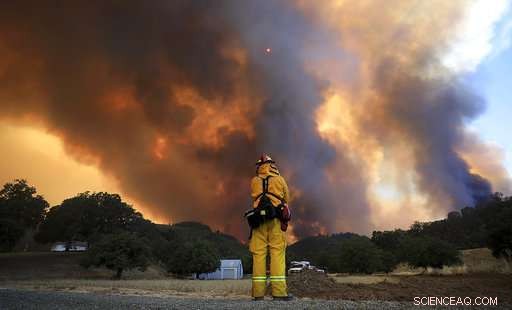
In questo 2 agosto, 2018, foto d'archivio, una torre di fumo si riversa da Cow Mountain come Burney, California, il vigile del fuoco Bob May tiene d'occhio la vegetazione circostante per individuare gli incendi durante l'incendio violento del fiume vicino a Lakeport, California. Gli incendi che hanno modellato a lungo il paesaggio degli Stati Uniti occidentali stanno diventando sempre più grandi e bruciano più a lungo, portando sempre più fumo soffocante, smottamenti mortali e perdita di habitat. (Kent Porter/The Press Democrat via AP, File)
Gli incendi negli Stati Uniti hanno carbonizzato più di 10, 000 miglia quadrate finora quest'anno, un'area più grande dello stato del Maryland, con grandi incendi che ancora bruciano in ogni stato occidentale, inclusi molti che non sono completamente contenuti.
Che sia innescato da un fulmine o da esseri umani, il fuoco è stato a lungo una forza che ha plasmato il paesaggio degli Stati Uniti occidentali.
Piccante, i venti secchi possono sferzare le fiamme in tempeste di fuoco che lasciano dietro di sé terre desolate carbonizzate soggette a erosione e frane. Altri incendi sgombrano il sottobosco, aprire il suolo della foresta alla luce del sole e stimolare la crescita.
Le agenzie governative negli ultimi decenni hanno effettivamente capovolto quel ciclo di distruzione e rinascita. Le politiche di soppressione degli incendi hanno permesso ai combustibili di accumularsi in molte foreste occidentali, rendendoli più suscettibili ai grandi incendi.
Queste influenze sono amplificate man mano che lo sviluppo si insinua sempre più in profondità nelle foreste e il cambiamento climatico porta temperature più calde. Immagini recenti di suddivisioni in fiamme mettono sotto i riflettori il potere e il ruolo ecologico degli incendi.
Uno sguardo agli effetti ambientali degli incendi boschivi:
FUMO E ROVINA
La maggior parte immediatamente il fuoco porta distruzione.
Le temperature da incendi estremi possono superare le 2, 000 gradi Fahrenheit, abbastanza caldi da uccidere tutta la vita vegetale, incenerire i semi nascosti sotto la superficie e cuocere il terreno finché non diventa impermeabile alla pioggia.
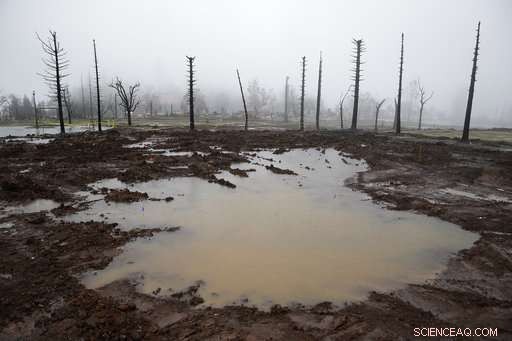
Questo 8 gennaio, 2018, la foto del file mostra le piscine di acqua piovana in piedi dove una volta sorgeva una casa del quartiere di Fountaingrove a Santa Rosa, California. Gli incendi che hanno modellato a lungo il paesaggio degli Stati Uniti occidentali stanno diventando sempre più grandi e bruciano più a lungo, portando sempre più fumo soffocante, smottamenti mortali e perdita di habitat. Che sia innescato da un fulmine o da esseri umani, il fuoco è stato a lungo una forza che ha plasmato il paesaggio degli Stati Uniti occidentali. (Foto AP/Eric Risberg, File)
Il paesaggio senza vita diventa soggetto a una grave erosione, incrostano corsi d'acqua e fiumi con limo che uccide i pesci e altre forme di vita acquatica. Torrenti di detriti fangosi a seguito degli incendi dell'anno scorso nel sud della California hanno ucciso 21 persone e distrutto 129 case.
Gli scienziati del Geological Survey degli Stati Uniti affermano che il problema sta peggiorando con l'aumento dell'area bruciata ogni anno dagli incendi. Uno studio dell'anno scorso ha concluso che i sedimenti dovuti all'erosione a seguito degli incendi raddoppieranno entro il 2050 per circa un terzo dei bacini idrografici occidentali.
Il fumo degli incendi boschivi dell'ovest di quest'estate, un potenziale pericolo per la salute di individui a rischio, ha provocato la chiusura dello Yosemite National Park per più di due settimane e si è spostato sulla costa orientale, secondo la Nasa. Recenti ricerche affermano che ha anche un impatto sui cambiamenti climatici poiché piccole particelle si muovono a spirale nell'atmosfera superiore e interferiscono con i raggi del sole.
DOMANDE CLIMATICHE
Gli scienziati concordano ampiamente che gli incendi stanno aumentando in Nord America e in altre parti del mondo mentre il clima si riscalda. Ma ancora emerge come quel cambiamento altererà la naturale progressione del fuoco e della ricrescita.
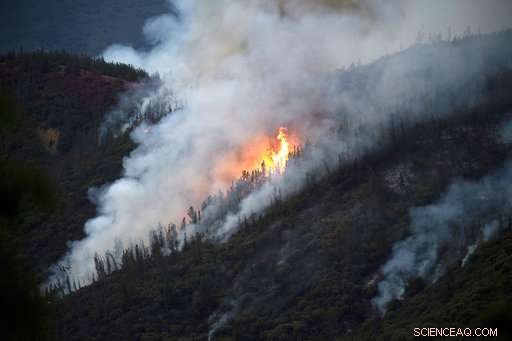
In questa domenica, 15 luglio 2018, foto d'archivio, le fiamme dell'incendio di Ferguson bruciano lungo una collina nella contea di Mariposa, California, vicino a Parco nazionale di Yosemite. Gli incendi negli Stati Uniti hanno carbonizzato più di 10, 000 miglia quadrate finora quest'anno, un'area più grande dello stato del Maryland, con grandi incendi che ancora bruciano in ogni stato occidentale, inclusi molti che non sono completamente contenuti. Piccante, i venti secchi possono sferzare le fiamme in tempeste di fuoco che lasciano dietro di sé terre desolate carbonizzate soggette a erosione e frane. (Foto AP/Noah Berger, File)
L'intervallo di tempo tra gli incendi in alcune località si sta riducendo, anche se c'è meno umidità per aiutare gli alberi a ricrescere. That means some forests burn, then never grow back, converting instead into shrub land more adapted to frequent fire, said Jonathan Thompson, a senior ecologist at Harvard University.
"They get stuck in this trap of repeated, high-severity fire, " Thompson said. "Through time we'll see the California shrub land shifting north."
Similar shifts are being observed in Colorado, Wyoming's Yellowstone National Park and Glacier National Park in Montana, Egli ha detto.
The relationship between climate and fire cuts both ways. A longer fire season and bigger fires in the boreal forests of Alaska and Canada are burning not just trees but also tundra and organic matter in soils, which hold roughly a third of the Earth's terrestrial carbon, said David Peterson, a former U.S. Forest Service research scientist.
The carbon enters the atmosphere and contributes to higher temperatures, leading to bigger fires that release yet more carbon.
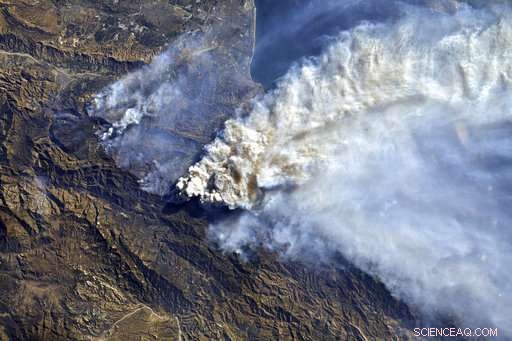
This Dec. 7, 2017 photo by NASA astronaut Randy Bresnik from the International Space Station shows smoke from California wildfires. Wildfires in the U.S. have charred more than 10, 000 square miles so far this year, an area larger than the state of Maryland, with large fires still burning in every Western state including many that are not fully contained. Whether sparked by lightning or humans, fire has long been a force shaping the landscape of the U.S. West. (Randy Bresnik/NASA via AP)
BIRD IN THE BALANCE
Life and property still top the list of priorities for firefighters, but in recent years another asset has been deemed worth extra protection in many Western states:a chicken-sized bird known as the greater sage grouse.
Fires burned an estimated 3, 240 square miles (8, 390 square kilometers) of the bird's sage bush habitat in 2017 and have burned almost 2, 400 square miles (6, 215 square kilometers) so far in 2018.
When sage brush burns, it's often replaced with a plant from Europe called cheatgrass, which crowds out native plants and is more prone to burning.
That's challenging government efforts to keep greater sage grouse off the endangered species list, which could restrict economic development.
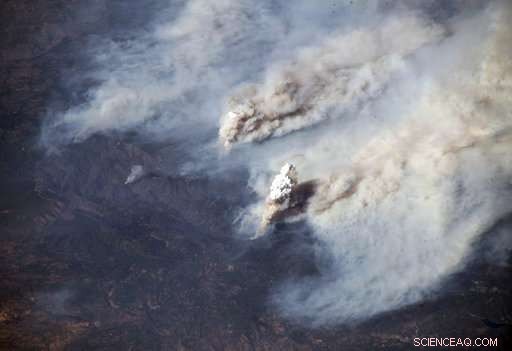
This Aug. 3, 2018, photo by European Space Agency astronaut Alexander Gerst aboard the International Space Station, provided by NASA, shows smoke from California's Carr and Ferguson fires blowing eastward across the western United States. Wildfires in the U.S. have charred more than 10, 000 square miles so far this year, an area larger than the state of Maryland, with large fires still burning in every Western state including many that are not fully contained. Whether sparked by lightning or humans, fire has long been a force shaping the landscape of the U.S. West. (Alexander Gerst/ESA/NASA via AP)
Areas considered crucial to the bird's survival now get extra attention:A military-type Blackhawk helicopter is under government contract to deploy quick-reaction teams to snuff out sage brush fires in portions of Idaho, Nevada, Utah and Oregon.
REGENERATION
A turning point in public understanding of the ecological importance of fire came in 1988 , when 1, 240 square miles (3, 200 square kilometers) of Yellowstone National Park burned.
The devastation, punctuated by images of wildlife fleeing flames, fed into the perception of wildfires as a menace to be battled.
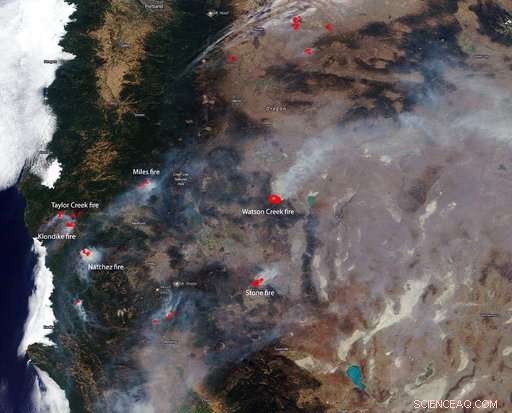
This NASA satellite image posted Aug. 20, 2018 shows several of the larger wildfires in both Oregon, superiore, and California. Wildfires in the U.S. have charred more than 10, 000 square miles so far this year, an area larger than the state of Maryland, with large fires still burning in every Western state including many that are not fully contained. Whether sparked by lightning or humans, fire has long been a force shaping the landscape of the U.S. West. (NASA tramite AP)
The events drew criticism of the park's "let it burn" policy. Officials didn't immediately squelch lightning-caused fires that June because they did not pose an immediate threat to life or property, but eventually ended up deploying 10, 000 firefighters.
By that fall, seedlings already were emerging in some burned out areas. Park biologist Roy Renkin recalls a visitor reacting with surprise a decade later when he told her a thick stand of young trees emerging from a burned area had come back on their own.
Lodgepole pines are commonly cited as an example of forest resiliency. The fire's heat releases seeds from the pine's cones.
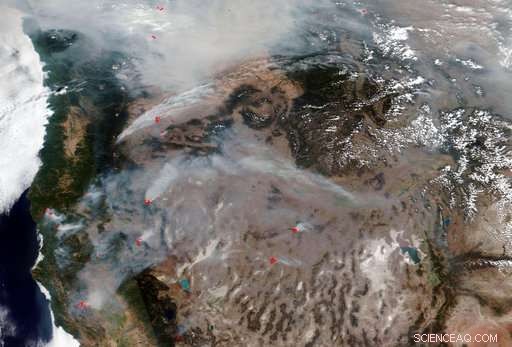
This image posted by the National Oceanic and Atmospheric Administration (NOAA), released by NASA, on Aug. 20, 2018, shows Western states, California at left, shrouded in smoke from the more than 100 large fires, including smaller fires within each complex of fires, that have erupted across the region during this fire season. Wildfires in the U.S. have charred more than 10, 000 square miles so far this year, an area larger than the state of Maryland, with large fires still burning in every Western state including many that are not fully contained. Whether sparked by lightning or humans, fire has long been a force shaping the landscape of the U.S. West. (NOAA tramite AP)
Several species of woodpeckers thrive on insects attracted to fire-killed trees. A plant called fireweed is specially adapted to take root in fire-damaged soils, multiplying rapidly and forming carpets of pink petals against a blackened backdrop.
"It's isn't all death and destruction, " Renkin said. "These forests have evolved with fire."
© 2018 The Associated Press. Tutti i diritti riservati.